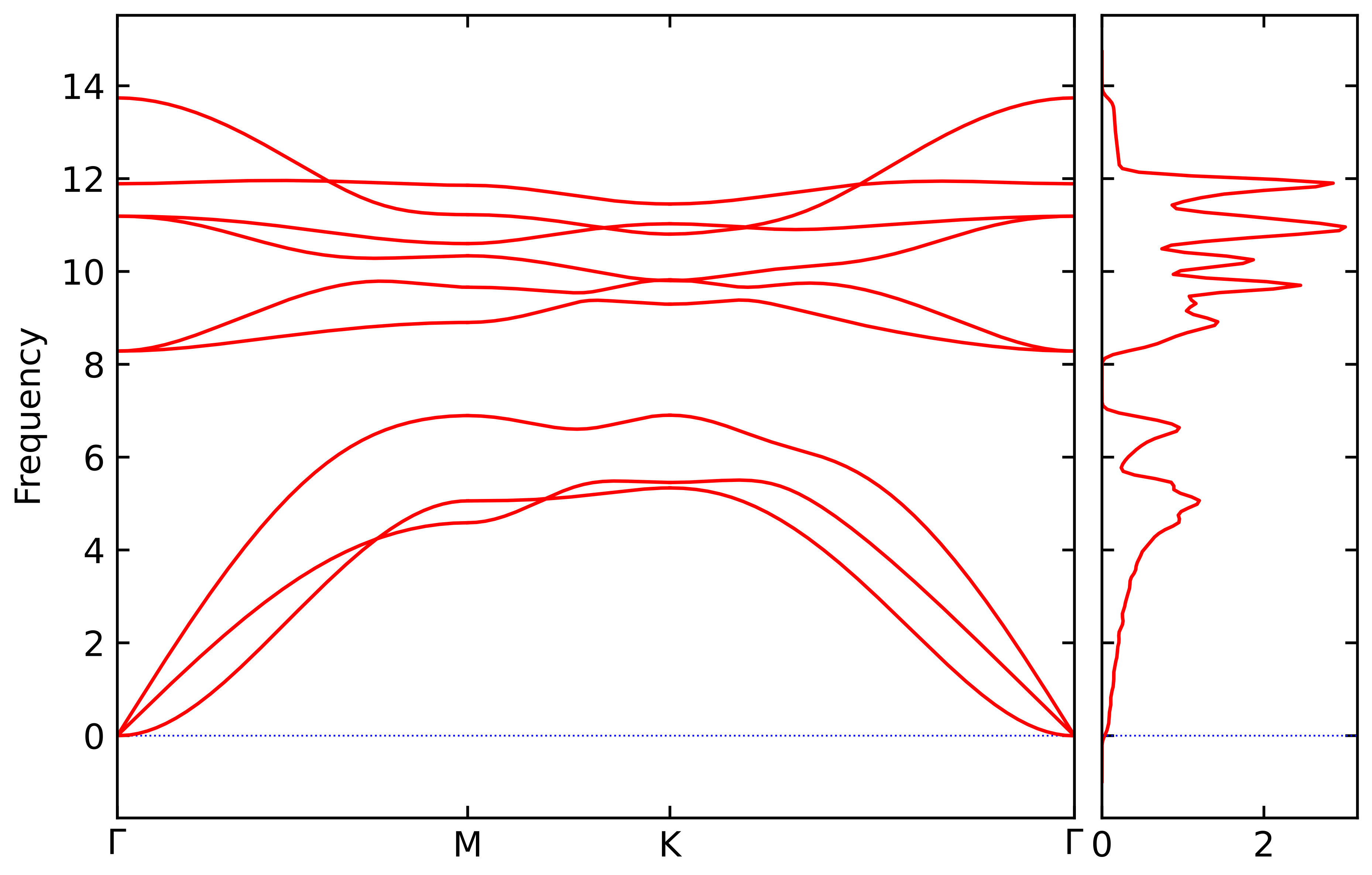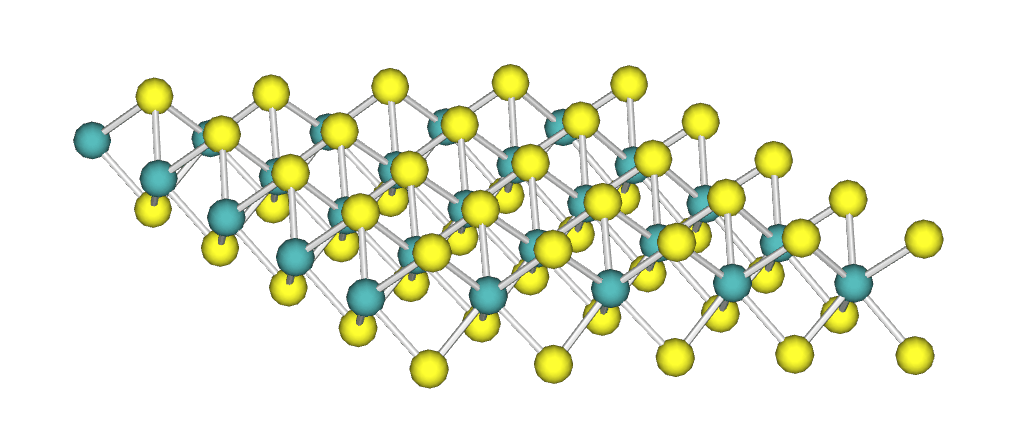Calculate phonon spectra by DFT
Phonons are quasiparticles representing the collective excitations of a crystal structure, describing the quantized modes of lattice vibrations that follow Bose-Einstein statistics. They are closely related to the thermodynamic properties of crystals. Therefore, calculating the phonon dispersion relations, or phonon spectra, is of great significance. This process involves obtaining the necessary force constants from first-principles (FP) calculations, followed by further processing and computations using tools like Phonopy. Two common FP methods for this purpose are the finite displacement method (FDM) and density functional perturbation theory (DFPT).
flowchart LR
A(Structure optimization) --> B(Supercell)
B --> D[FDM by VASP]
B --> E[DFPT by VASP]
D --> F[Force constants]
E --> F[Force constants]
F --> G[Phonon spectra]
Here I’m gonna use monolayer molybdenum disulfide (MoS₂) as an example to elaborate on the process:
1. Structure optimization
Perform high-precision structure optimization of the initial unit cell, which can be from some tools like ASE , optimizing both lattice constants and atomic positions.
-
INCAR tag [ISIF]: 2: Keep lattice constants, and only optimize atomic positions; 3: The lattice constants, atomic positions, and volume are all optimized; 4: The lattice constants and atomic positions are optimized, but the volume does not.WARNING
Using
ISIF=3for relaxation, which is unsuitable for 2D systems with vacuum as it may collapse the cell. Recommend usingISIF=4to keep cell volume constant while relaxing lateral lattice parameters. -
Global Parameters ISTART = 0 # Read existing wavefunction, if there ISPIN = 1 # Non-Spin polarised DFT ICHARG = 2 # The initial guess charge density is generated by superposition of atomic charge density LREAL = Auto # Projection operators: False, important for phonon dispersion ENCUT = 650 # Cut-off energy for plane wave basis set, in eV PREC = Accurate # Precision level: Normal or Accurate, set Accurate when perform structure lattice relaxation calculation LWAVE = .FALSE. # Write WAVECAR or not LCHARG = .FALSE. # Write CHGCAR or not ADDGRID= .TRUE. # Increase grid, helps GGA convergence Electronic Relaxation ISMEAR = -5 # Gaussian smearing, metals:1 SIGMA = 0.05 # SIGMA is ignored for the tetrahedron method when ISMEAR = -5 ALGO = N # To specify the electronic minimisation algorithm NELM = 120 # Max electronic SCF steps NELMIN = 6 # Min electronic SCF steps EDIFF = 1E-06 # SCF energy convergence, in eV # GGA = PS # PBEsol exchange-correlation Ionic Relaxation NSW = 120 # Max ionic steps IBRION = 2 # Algorithm: 0-MD, 1-Quasi-New, 2-CG ISIF = 4 # Stress/relaxation: 2-Ions, 3-Shape/Ions/V, 4-Shape/Ions EDIFFG = -0.02 # Ionic convergence, eV/AA ISYM = -1 # Symmetry: -1=switched off, 0=none, 2=GGA, 3=hybrids -
Global Parameters ISTART = 0 # Read existing wavefunction, if there ISPIN = 1 # Non-Spin polarised DFT ICHARG = 2 # The initial guess charge density is generated by superposition of atomic charge density LREAL = Auto # Projection operators: False, important for phonon dispersion ENCUT = 650 # Cut-off energy for plane wave basis set, in eV PREC = Accurate # Precision level: Normal or Accurate, set Accurate when perform structure lattice relaxation calculation LWAVE = .FALSE. # Write WAVECAR or not LCHARG = .FALSE. # Write CHGCAR or not ADDGRID= .TRUE. # Increase grid, helps GGA convergence Electronic Relaxation ISMEAR = -5 # Gaussian smearing, metals:1 SIGMA = 0.05 # SIGMA is ignored for the tetrahedron method when ISMEAR = -5 ALGO = N # To specify the electronic minimisation algorithm NELM = 120 # Max electronic SCF steps NELMIN = 6 # Min electronic SCF steps EDIFF = 1E-08 # SCF energy convergence, in eV # GGA = PS # PBEsol exchange-correlation Ionic Relaxation NSW = 120 # Max ionic steps IBRION = 2 # Algorithm: 0-MD, 1-Quasi-New, 2-CG ISIF = 2 # Stress/relaxation: 2-Ions, 3-Shape/Ions/V, 4-Shape/Ions EDIFFG = -1E-04 # Ionic convergence, eV/AA ISYM = -1 # Symmetry: -1=switched off, 0=none, 2=GGA, 3=hybrids
Here is the structure file of MoS₂ with the POSCAR format:
Mo S
1.0000000000000000
3.1600000000000001 0.0000000000000000 0.0000000000000000
-1.5800000000000001 2.7366402759588260 0.0000000000000000
0.0000000000000000 -0.0000000000000000 17.2500000000000000
Mo S
1 2
Cartesian
0.0000000000000000 0.0000000000000000 8.6250000000000000
1.5799999999999998 0.9122134253196086 10.2500000000000000
1.5799999999999998 0.9122134253196086 7.0000000000000000
Here is it after relaxation (CONTCAR file):
Mo S
1.000000000000000
3.1857089607817932 0.0000000218282313 0.0000000024895515
-1.5928544581578377 2.7589049024719241 0.0000000011539288
0.0000000310083557 0.0000000002516627 16.9727051455909148
Mo S
1 2
Direct
-0.0000000007065635 -0.0000000020440497 0.4999999968674809
0.6666666662068135 0.3333333335809116 0.5920061449599645
0.6666666678330786 0.3333333351298096 0.4079938581725475
0.00000000E+00 0.00000000E+00 0.00000000E+00
0.00000000E+00 0.00000000E+00 0.00000000E+00
0.00000000E+00 0.00000000E+00 0.00000000E+00
After completing the full optimization, the CONTCAR file is obtained, allowing us to proceed to the next step.
2. Build supercell
The Phonopy package provides a convenient way for effortlessly expanding the cell.
phonopy -d --dim='8 8 1’ -c CONTCAR
where the CONTCAR file is the structure after optimization.
After that, we will get the following files:
-
POSCAR-{num}: Displacement files representing structures with slight atomic shifts, numbered by symmetry modes, which will be used to calculate forces for force constants. (for FDM) -
SPOSCAR: Abbreviation for “Supercell POSCAR”. (for DFPT) -
phonopy_disp.yaml: Displacement information file, including direction, amplitude, etc.
The following command is batch processing for FDM calculation preparation:
for i in 001 002 003; do mkdir -p $i && mv POSCAR-$i $i/POSCAR; done
3. Run VASP
-
FDM: Perform single-point calculations in VASP using each displaced
POSCAR-{num}file.DFPT: Perform phonon calculation in VASP using
SPOSCARfile.The
POTCARandKPOINTSfiles can be generated by the VASPKIT tool.WARNING
You may need to adjust some parameters based on your tests and experience! Note: DFPT requires a significant amount of memory.
-
# Global Parameters ISTART = 0 # Not Read existing wavefunction; if there ISPIN = 1 # Non-Spin polarised DFT, Default=1 ICHARG = 2 # The initial guess charge density is generated by superposition of atomic charge density LREAL = .FALSE. # Projection operators: automatic ENCUT = 650 # Cut-off energy for plane wave basis set, in eV LWAVE = .FALSE. # Write WAVECAR or not LCHARG = .FALSE. # Write CHGCAR or not PREC = Accurate # Precision level KGAMMA = .TRUE. # GAMMA point KSPACING = 0.25 # Automatically calculate k-points ALGO = Normal # Static Calculation NSW = 1 # Default: NSW = 0 IBRION = -1 # Ions are not moved ISMEAR = -5 # gaussian smearing method SIGMA = 0.02 # SIGMA is ignored for the tetrahedron method when ISMEAR = -5 EDIFF = 1E-08 # SCF energy convergence; in eV NELM = 150 # Max electronic SCF steps KPAR = 4 # make 4 groups, each group working on one set of k-points NCORE = 8 # one orbital handled by 4 cores -
# For phonon calculation PREC = Accurate # Precision level: Normal or Accurate, set Accurate when perform structure lattice relaxation calculation ENCUT = 750 # Cut-off energy for plane wave basis set, in eV NSW = 1 IBRION = 8 # IBRION=8: second derivatives, Hessian matrix, and phonon frequencies (perturbation theory use symmetry) EDIFF = 1.0e-8 # SCF energy convergence, in eV EDIFFG = -1E-03 # Ionic convergence; negetive -- force (eV/AA) IALGO = 38 # IALGO=38: Blocked-Davidson algorithm (ALGO=N) ISMEAR = 0 # Gaussian smearing, metals:1 SIGMA = 0.02 # Smearing value in eV, metals:0.2) LREAL = .FALSE. # Projection operators are evaluated in (F:reciprocal space) (T:real space(not recommended) ADDGRID = .TRUE. # Increase grid; helps GGA convergence LWAVE = .FALSE. # Write WAVECAR file or not LCHARG = .FALSE. # Write CHGCAR file or not
4. Get force constants info.
After VASP run, you can get the force constants file by :
For FDM, get FORCE_SETS, which contains force and displacement information for perturbed structures:
phonopy -f 001/vasprun.xml 002/vasprun.xml 003/vasprun.xml
For DFPT, get FORCE_CONSTANTS:
phonopy --fc vasprun.xml
5. Get phonon properties
Prepare band.conf, and get the phonon spectra, also phonon density of states (DOS).
ATOM_NAME = Mo S
DIM = 8 8 1
BAND= 0.0 0.0 0.0 0.5 0.0 0.0 0.3333 0.3333 0.0 0.0 0.0 0.0
FORCE_CONSTANTS = READ
EIGENVECTORS = .TRUE.
GROUP_VELOCITY = .TRUE.
BAND_POINTS = 2001
BAND_LABELS = $\Gamma$ M K $\Gamma$
MP = 30 30 1
DOS = .TRUE.
SIGMA = 0.1
Run the following two commands:
phonopy -p -s band.conf -c POSCAR_uc
phonopy-bandplot --gnuplot > PBAND.dat
You will get the figure and data in PBAND.dat:


References
[1] Phonons from finite differences – VASP
[2] Phonons from density-functional-perturbation theory – VASP
Enjoy Reading This Article?
Here are some more articles you might like to read next: